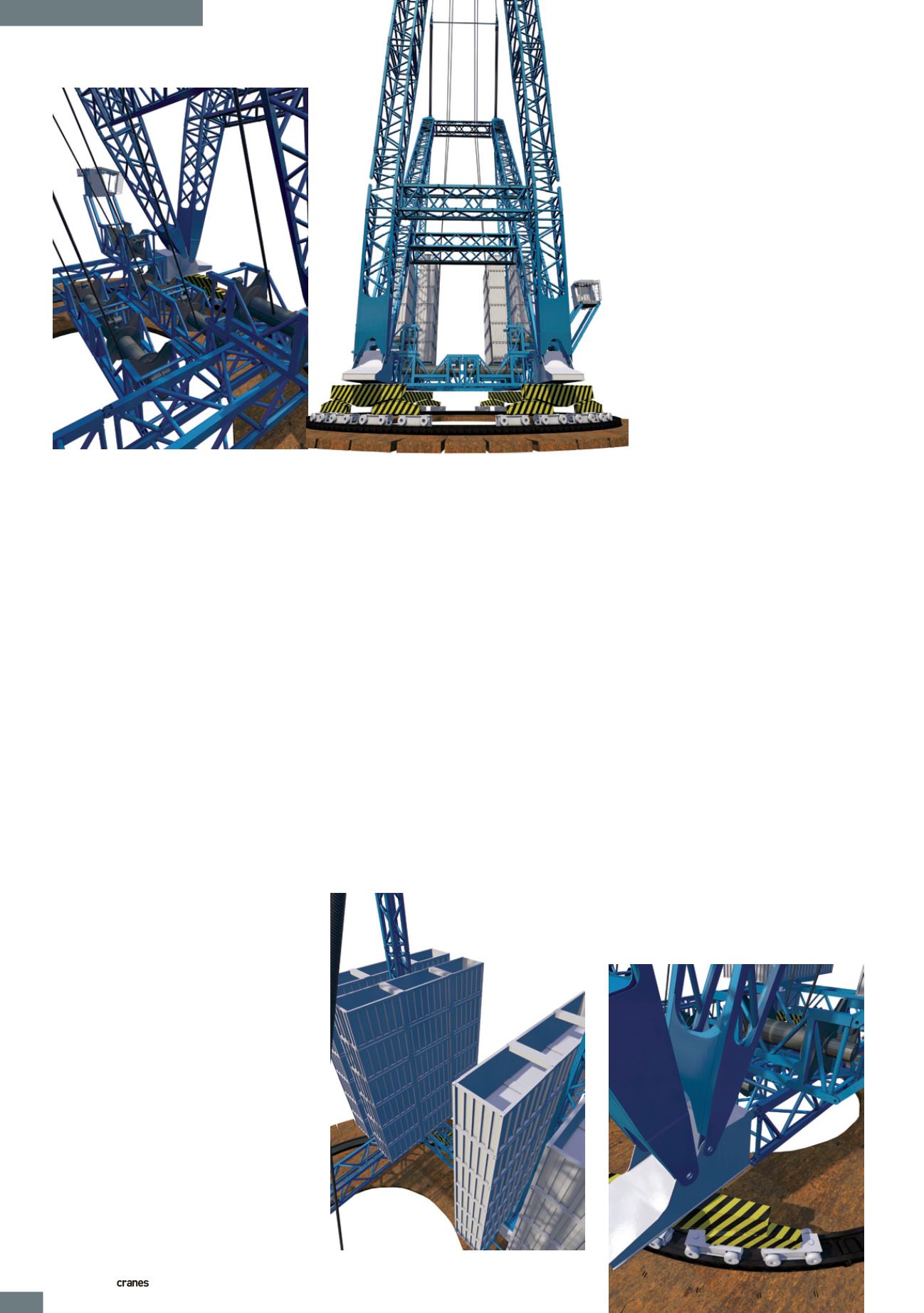
PRODUCT NEWS
INTERNATIONAL AND SPECIALIZED TRANSPORT
■
SEPTEMBER 2013
12
is rarely an issue as in 90 % of cases, this
feature is not required, van Seumeren said.
Large scale
A primary feature of the CRC is its
scalable modular design. Components,
including boom and jib sections, ring
parts, winches and more are transferrable
from one size crane to another. Adding
more of the same parts allows the larger
cranes to be built. By buying the largest
crane, a customer can also build the
smaller cranes, with just the addition of
some different radius parts for smaller
diameter rings. The same winches are used
for the main hoist, boom and auxiliary
(250 tonne capacity) hoists.
Light and heavy type single and double
chord boom sections are used. To increase
capacity the sections can be doubled up by
pinning on an extra chord top and bottom.
This applies to the main boom, the back
mast and the jib sections. For most
configurations the CRC can erect itself,
van Seumeren said.
A single ring is used for the 2,400 tonne
capacity units up to 100,000 tonne-metres.
For the 3,600 and 4,800 tonne models
there is a double ring and a total of four
ring diameters are used across the whole
range. Rings range from 23 to 48 m in
diameter and are in 8 to 14 segments. Two
types of spreader board are used across the
range and the ground bearing pressure is
typically 20 tonnes per square metre while
on the largest model this can be up to 30
tonnes per square metre.
The main boom and the back mast are
supported directly on the front bogies and
the ballast containers bear directly on the
rear ones. The same bogies work across
the range and can also be set to run in a
straight line. Bogies and spreader boards
can be shipped in flat rack containers.
All of the components can be
transported inside shipping containers.
Boom sections can be left pinned together
as monoblocks or dismantled for shipment
on flat rack or open top containers. The
winch drums, spooled with all their wire
rope, are lifted out of their frames for
transport. The frames are the dimensions
for a standard 20 foot shipping container.
It is up to the customer to decide if they
want to transport by container or not.
Most components can be shipped as 20 or
40 foot container size loads.
Ballast required increases from 2,400
tonnes on the smallest models, thru 3,600
tonnes in the mid-range, to 4,800 tonnes
on the largest models. For the main ballast
between 24 and 48 specially reinforced
containers can be filled with locally
sourced sand, rock or steel, according to
what is available.
Electrical power
A departure from convention on such
cranes is that the CRC will be 100 %
electrically powered, driven by AC motors.
Power can either be from the local grid
or supplied by on site generators. It will
avoid the emerging problem of engines
on the crane being needed to run on
low sulphur diesel in some markets
but there being no cross-market
compatibility (For a comprehensive
explanation of this problem see
IC
March
2013, page 57). Where the local mains
electrical power is insufficient, generators
will be used that conform to local
regulations and fuel type requirements.
Greater efficiency and lower power
consumption are two more claimed benefits
of electric drives. Others include cleaner
and neater installation and operation.
Optimisation is a key feature. The
winches are incorporated as part of the
structure and not just separate elements
added to it with unnecessary extra weight
of additional structure. An analogy can
be drawn with Colin Chapman’s approach
at Lotus Cars where the idea was to “add
lightness” (i.e. reduce weight) by making
each component serve as many functions
as possible and then to reduce the weight
of those pieces as far as practical without
compromising strength.
Get updates on this story at
and in
IC
.
■
The winches in their frames form part of the
CRC crane structure
The CRC has a single ring up to 100,000 tonne-
metres and then it switches to two rings. The
tracks for the rings can be transported on flat
rack containers
The main ballast consists of between 24 and 48
specially reinforced containers, each weighing
100 tonnes, filled with locally sourced material
The same bogies can be used for all sizes
of the CRC crane. Between 64 and 128
bogie wheels are used


